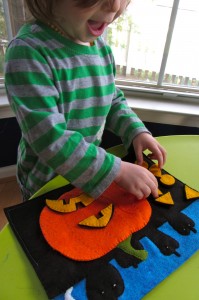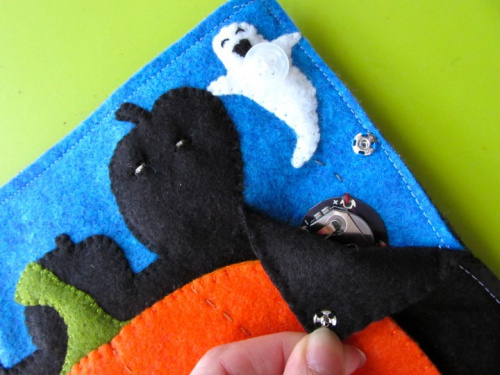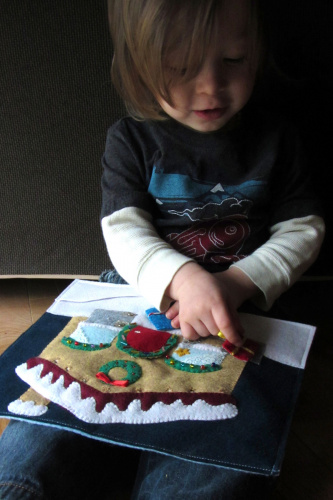Stephanie Segall is a graphic designer and mom who, after looking for an interactive way to keep her 2-year-old son Jackson entertained, combined her familiarity with the world of electronics with her love of crafting, and created her Quiet Books. Some of the books, which are made of felt and contain interchangeable parts to max out a kid's creativity, also include LilyPad components and LEDs, and light up with the push of a button. She posts detailed tutorials for her designs on her site, Imagine Our Life. Segall's creations caught the attention of Wired in August, and she recently took some time to talk to SparkFun about her latest Quiet Book project and inspiration.
1. Can you tell us a little bit about yourself and what you do?
By day, I am a freelance graphic designer. I work from home and care for our son Jackson, who turns three in February. But, my passion is for making anything creative or crafty. My mother, who died when I was young, passed on her artistic skills and love of crafting to me. All of my female relatives were very into various needle arts, so I learned to sew at a young age. But by contrast, I grew up in a house with just my dad (an astrophysicist) and my older brother (a programmer). My childhood was filled with Apple computers, 2400 baud modems and episodes of Star Trek and Dr Who. Perhaps it was inevitable that one day art and science would meet in one of my projects.
2. How does the quiet book work?
Quiet books are fabric books filled with activities a young child can do in situations where being quiet and patient is necessary. Traditionally, they were made for church, but they are also great for long car and plane rides or in waiting rooms. Early quiet books usually featured the same set of pages: tying a shoe, answering the (rotary) phone or practicing with a zipper. When I stumbled upon the idea of quiet books, I knew I could make some really amazing, updated takes on the traditional ideas. My zipper page uses a rocket to unzip and reveal the flames as it takes off into space. My phone page was updated to an iPhone with numbers to count. I love making my quiet book pages full of activities and new concepts for Jax to learn.
3. What was the inspiration for the LED quiet book pages, and for your newest book?
When I first read about SparkFun and LilyPad, I filed them away in my brain as something I definitely had to try. Robot pages are popular in quiet books, with panels of sewn buttons and zippers to play with. What better way to try LEDs than with a build-a-robot activity? With help from my brother, I was able to learn how the circuits needed to be wired. The LilyPad parts were easy to use - especially since I was simply sewing everything together with conductive thread!
I recently decided to make a series of quiet book pages celebrating the four seasons, as Jax is now old enough to be aware of the changing weather and the holidays we celebrate. I plan to make eight pages for our Seasons quiet book - one page for each season, and one page for a holiday from that season. I just completed our Halloween page for the autumn section. I added a simple arrangement of LEDs to add glowing eyes to the page. It is a great first project or starting point for those who want to work with e-textiles.
My most recently completed page is my most ambitious to date. A Christmas page featuring a decorated house and a shape puzzle. When you match up the shapes - a Christmas tree and two presents - the LEDs light up to let you know you are right! Jax knew right away what the page was for when he saw the puzzle pieces. But he was surprised and delighted when he put them in the right place and saw the lights come on. I know he is going to be excited next month when we decorate our house with holiday lights. He will tell us it is just like "his" house in his quiet book.
4. How long did your newest project take to complete?
The holiday house puzzle definitely took longer than most of my pages. I can typically get a page done in a week and a half - sewing one hour each evening and several hours each weekend day. This page took longer, but only because I sewed the circuitry three times before I decided I was happy with it. It worked all three times, but I needed to find the perfect balance between having a tutorial that is easy to understand and follow and having the least amount of room for user error. I always try to explain my sewing projects down to the smallest detail, and my e-textile projects have been no different.
Still to come are two more holiday pages and the four season pages. I plan to use LilyPad LEDs in two more pages of the Season book. A fireworks page for summer is pretty much guaranteed. I'm still brainstorming the best way to include e-textiles into a spring layout.
5. What materials did you use?
My holiday house puzzle page included my normal sewing supplies, such as wool felt, embroidery thread, ribbons and beads. But to make it interactive, I used parts from the LilyPad line as well as conductive thread and fabric. The LilyPad parts I used included: red LEDs, blue LEDs, a yellow LED and a battery holder.
6. Where do you hope your LED quiet book project will go in the future, and what do you hope people will gain from it?
After having tried e-sewing and experienced how easy it is to incorporate into sewing projects, I knew I wanted to spread the word about it in my community of moms who sew. I want to show other craft lovers that e-textiles are not scary. In fact, they are very forgiving, as you can always rip out your thread and try again! Quiet books and other fabric activities for kids are a perfect pair for e-textiles, adding a whole new level of interaction that didn't exist in quiet books of earlier generations.
7. What would be your advice for someone hoping to make their own electronics project?
To those who want to try incorporating electronics into their craft projects, don't be afraid! Products such as LilyPad make it very easy to get started. Think about what you want as a final project and draw out your plans before you begin sewing. Ask a technically-inclinded friend for help or read online tutorials to learn the basics of the wiring. Start simple, and soon you will be ready to design more complex pieces.











I can't sew :( Well not very well anyways. Great post!
Absolutely amazing!